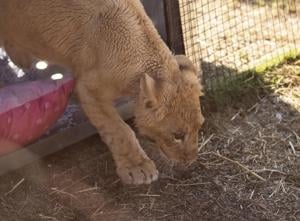PAARL, South Africa (AP) — Freya, a 6-month-old lion cub rescued from the wildlife trade in Lebanon, poked a curious nose out of her transport crate and sniffed the air. Satisfied, she took her first cautious steps in her new forever home in a sanctuary in South Africa. Freya’s relocation to the Drakenstein Lion Park is only a partial success story.
She will never live as a lion should in the wild. She has been given lifetime sanctuary at Drakenstein, which has taken in other lions from zoos and circuses in France, Chile, Romania and elsewhere. Some have terrible backstories of abuse, noted on placards at the sanctuary: Ares was blind and neglected when he was rescued.

Brutus had been beaten hard enough to break his jaw. But as Freya settles in at Drakenstein, animal welfare groups have again drawn attention to South Africa’s contradictory position when it comes to the species that often symbolizes African wildlife. South Africa, with an admirable reputation for conservation and ethical sanctuaries like Drakenstein, also has where the big cats are bred for petting and other encounters but also for killing in “canned hunting” experiences or for the .
South Africa has special permission through the endangered plant and animal trade treaty CITES to export lion bones and skeletons, mostly to Southeast Asia to be used in traditional medicines. Canned hunting, where lions are chased down and shot in enclosures with no chance of a fair chase or escape, is also legal. Anima.























